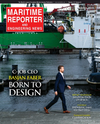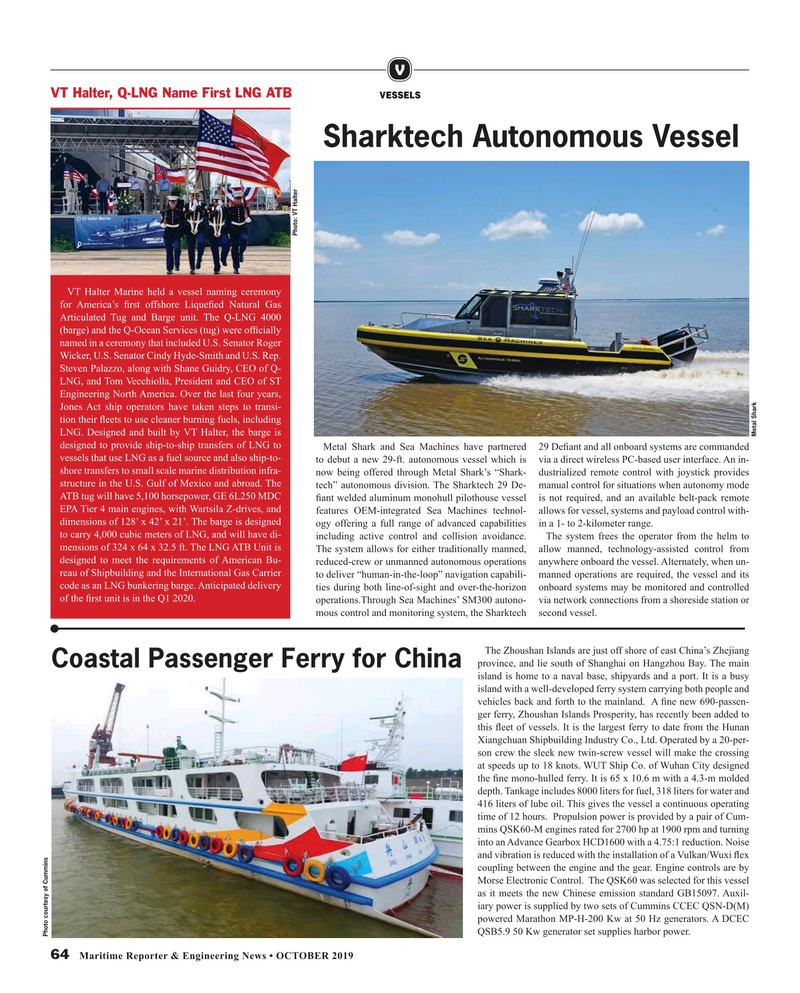
Page 64: of Maritime Reporter Magazine (October 2019)
Marine Design Annual
Read this page in Pdf, Flash or Html5 edition of October 2019 Maritime Reporter Magazine
V
VT Halter, Q-LNG Name First LNG ATB
VESSELS
Sharktech Autonomous Vessel
Photo: VT Halter
VT Halter Marine held a vessel naming ceremony for America’s ? rst offshore Lique? ed Natural Gas
Articulated Tug and Barge unit. The Q-LNG 4000 (barge) and the Q-Ocean Services (tug) were of? cially named in a ceremony that included U.S. Senator Roger
Wicker, U.S. Senator Cindy Hyde-Smith and U.S. Rep.
Steven Palazzo, along with Shane Guidry, CEO of Q-
LNG, and Tom Vecchiolla, President and CEO of ST
Engineering North America. Over the last four years,
Jones Act ship operators have taken steps to transi- tion their ? eets to use cleaner burning fuels, including
LNG. Designed and built by VT Halter, the barge is
Metal Shark designed to provide ship-to-ship transfers of LNG to
Metal Shark and Sea Machines have partnered 29 De? ant and all onboard systems are commanded vessels that use LNG as a fuel source and also ship-to- to debut a new 29-ft. autonomous vessel which is via a direct wireless PC-based user interface. An in- shore transfers to small scale marine distribution infra- now being offered through Metal Shark’s “Shark- dustrialized remote control with joystick provides structure in the U.S. Gulf of Mexico and abroad. The tech” autonomous division. The Sharktech 29 De- manual control for situations when autonomy mode
ATB tug will have 5,100 horsepower, GE 6L250 MDC ? ant welded aluminum monohull pilothouse vessel is not required, and an available belt-pack remote
EPA Tier 4 main engines, with Wartsila Z-drives, and features OEM-integrated Sea Machines technol- allows for vessel, systems and payload control with- dimensions of 128’ x 42’ x 21’. The barge is designed ogy offering a full range of advanced capabilities in a 1- to 2-kilometer range.
to carry 4,000 cubic meters of LNG, and will have di- including active control and collision avoidance. The system frees the operator from the helm to mensions of 324 x 64 x 32.5 ft. The LNG ATB Unit is
The system allows for either traditionally manned, allow manned, technology-assisted control from designed to meet the requirements of American Bu- reduced-crew or unmanned autonomous operations anywhere onboard the vessel. Alternately, when un- reau of Shipbuilding and the International Gas Carrier to deliver “human-in-the-loop” navigation capabili- manned operations are required, the vessel and its code as an LNG bunkering barge. Anticipated delivery ties during both line-of-sight and over-the-horizon onboard systems may be monitored and controlled of the ? rst unit is in the Q1 2020. operations.Through Sea Machines’ SM300 autono- via network connections from a shoreside station or mous control and monitoring system, the Sharktech second vessel.
The Zhoushan Islands are just off shore of east China’s Zhejiang province, and lie south of Shanghai on Hangzhou Bay. The main
Coastal Passenger Ferry for China island is home to a naval base, shipyards and a port. It is a busy island with a well-developed ferry system carrying both people and vehicles back and forth to the mainland. A ? ne new 690-passen- ger ferry, Zhoushan Islands Prosperity, has recently been added to this ? eet of vessels. It is the largest ferry to date from the Hunan
Xiangchuan Shipbuilding Industry Co., Ltd. Operated by a 20-per- son crew the sleek new twin-screw vessel will make the crossing at speeds up to 18 knots. WUT Ship Co. of Wuhan City designed the ? ne mono-hulled ferry. It is 65 x 10.6 m with a 4.3-m molded depth. Tankage includes 8000 liters for fuel, 318 liters for water and 416 liters of lube oil. This gives the vessel a continuous operating time of 12 hours. Propulsion power is provided by a pair of Cum- mins QSK60-M engines rated for 2700 hp at 1900 rpm and turning into an Advance Gearbox HCD1600 with a 4.75:1 reduction. Noise and vibration is reduced with the installation of a Vulkan/Wuxi ? ex coupling between the engine and the gear. Engine controls are by
Morse Electronic Control. The QSK60 was selected for this vessel as it meets the new Chinese emission standard GB15097. Auxil- iary power is supplied by two sets of Cummins CCEC QSN-D(M) powered Marathon MP-H-200 Kw at 50 Hz generators. A DCEC
QSB5.9 50 Kw generator set supplies harbor power.
Photo courtesy of Cummins 64 Maritime Reporter & Engineering News • OCTOBER 2019
MR #10 (59-65).indd 64 10/7/2019 9:57:22 AM

 63
63

 65
65
